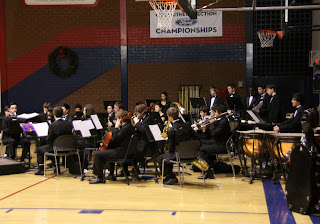 I
am back in my office after having spent a delightful hour in the Duffy Lewis
Gymnasium enjoying a magnificent Student Christmas Assembly put on by the
Visual and Performing Arts Department. There was something for everyone…the 48 voice Choir sang, the elite Jazz Ensemble performed, as did the Advanced Band,
the newly formed String Ensemble wowed the students with their technique, the
Dance program was showcased, including two students who compete in Irish Step
Dancing. There were soloists and a video
(produced by the students in the Film and Digital Media Program) entitled The
Art Project that featured interviews of student members of the Visual and
Performing Arts Department talking about the impact Art (in all of its
manifestations) had on their individual development.
I
am back in my office after having spent a delightful hour in the Duffy Lewis
Gymnasium enjoying a magnificent Student Christmas Assembly put on by the
Visual and Performing Arts Department. There was something for everyone…the 48 voice Choir sang, the elite Jazz Ensemble performed, as did the Advanced Band,
the newly formed String Ensemble wowed the students with their technique, the
Dance program was showcased, including two students who compete in Irish Step
Dancing. There were soloists and a video
(produced by the students in the Film and Digital Media Program) entitled The
Art Project that featured interviews of student members of the Visual and
Performing Arts Department talking about the impact Art (in all of its
manifestations) had on their individual development.
As
I returned to my office, I was struck by two different impressions; the first
focused on the obvious - the amazing depth and breadth of student artistic
talent which is drawn to La Salle’s VPA program - and, the less obvious but no
less important, phenomenal reaction of their student colleagues who cheered
and, at one point, initiated a standing ovation, in appreciation of the
accomplishments of the student artists performing on the gym floor. As I watched the performance, I realized how
much the community of La Salle takes for granted the unique elements - one of
which is our four-year Arts Program - that distinguish us from other private
high schools in the greater Pasadena
As
I reflected on these taken-for-granted elements of the La Salle Difference, it occurred to me that I’m probably not the
only Lancer who assumes that the day-to-day experience of the teenagers
entrusted to our care is normative for all high school students. Sadly, in
fact, for most California La Salle .
While more than one research study highlights the value of exposure to the Arts
for all educational disciplines; the
Arts are among the first programs to fall prey to the budget axe in the public
sector. Budget cuts and the Great Recession have reduced these opportunities
for most high school students in the Golden
State California
In his forward
to the 2011 report of the President’s Committee on the Arts and the Humanities:
Re-Investing in Arts Education: Winning
America’s Future Through Creative Schools, US Secretary of Education, Arne
Duncan made this observation:
The opportunity to learn about the arts and to perform as artists is an
essential part of a well-rounded curriculum and complete education. The study
of drama, dance, music, and the visual arts helps students explore realities,
relationships, and ideas that cannot be conveyed simply in words or numbers.
The ability to perform and create in the fine arts engenders innovative
problem-solving skills that students can apply to other academic disciplines
and provides experiences working as a team.
This
is not a screed against the tortured financial politics of the Golden
State La
Salle .
